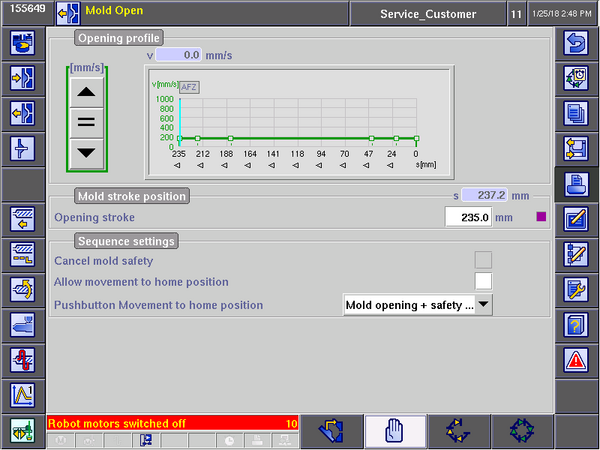Specific Process Knowledge/Back-end processing/Polymer Injection Molder/Demolding: Difference between revisions
| Line 7: | Line 7: | ||
[[File:06-demold.png|600px|thumb|left|Parameters for opening the mold is found on the 'Mold Open' screen.]] | [[File:06-demold.png|600px|thumb|left|Parameters for opening the mold is found on the 'Mold Open' screen.]] | ||
<br><br> | <br><br> | ||
*'''Opening profile''': | *'''Opening profile''': A constant speed can be set using the '=' button or the arrows. Alternatively individual points of the graph can be edited. If samples tend to break during demolding it might help lowering the opening speed. In general the speed should be low towards the end position (fully open position) to avoid violently slamming the mold against the end stop | ||
*'''Mold stroke position''': | *'''Mold stroke position''': This value defines how far the mold opens. It should generally be avoided to open the mold all the way to the end position, since this causes the mold to bang violently into the end stop. If this happens (you hear a bang every time the mold reaches the open position) decrease the mold stroke position by a few millimeter (e.g. change the stroke from 235 mm to 232 mm). Remember that changing the opening stroke will also change to robot's take-off position, so remember to adjust the take off position accordingly. | ||
*'''Sequence settings''': | *'''Sequence settings''': These settings change how the robot is allowed to move around the mold. These settings should generally not be changed (be very careful if you do) to avoid crashing the robot into the mold. | ||
Revision as of 11:37, 8 February 2018
Demolding
Demolding is the process of opening the mold and thereby pulling the sample off the shim. Many of the previously mentioned parameter will influence the demolding process. Generally, the higher the mold temperature, faster injection speed and higher switchover/after pressure, the more difficult it can be to demold the sample.
The demolding settings are can be found on the 'Mold open' screen:

- Opening profile: A constant speed can be set using the '=' button or the arrows. Alternatively individual points of the graph can be edited. If samples tend to break during demolding it might help lowering the opening speed. In general the speed should be low towards the end position (fully open position) to avoid violently slamming the mold against the end stop
- Mold stroke position: This value defines how far the mold opens. It should generally be avoided to open the mold all the way to the end position, since this causes the mold to bang violently into the end stop. If this happens (you hear a bang every time the mold reaches the open position) decrease the mold stroke position by a few millimeter (e.g. change the stroke from 235 mm to 232 mm). Remember that changing the opening stroke will also change to robot's take-off position, so remember to adjust the take off position accordingly.
- Sequence settings: These settings change how the robot is allowed to move around the mold. These settings should generally not be changed (be very careful if you do) to avoid crashing the robot into the mold.
